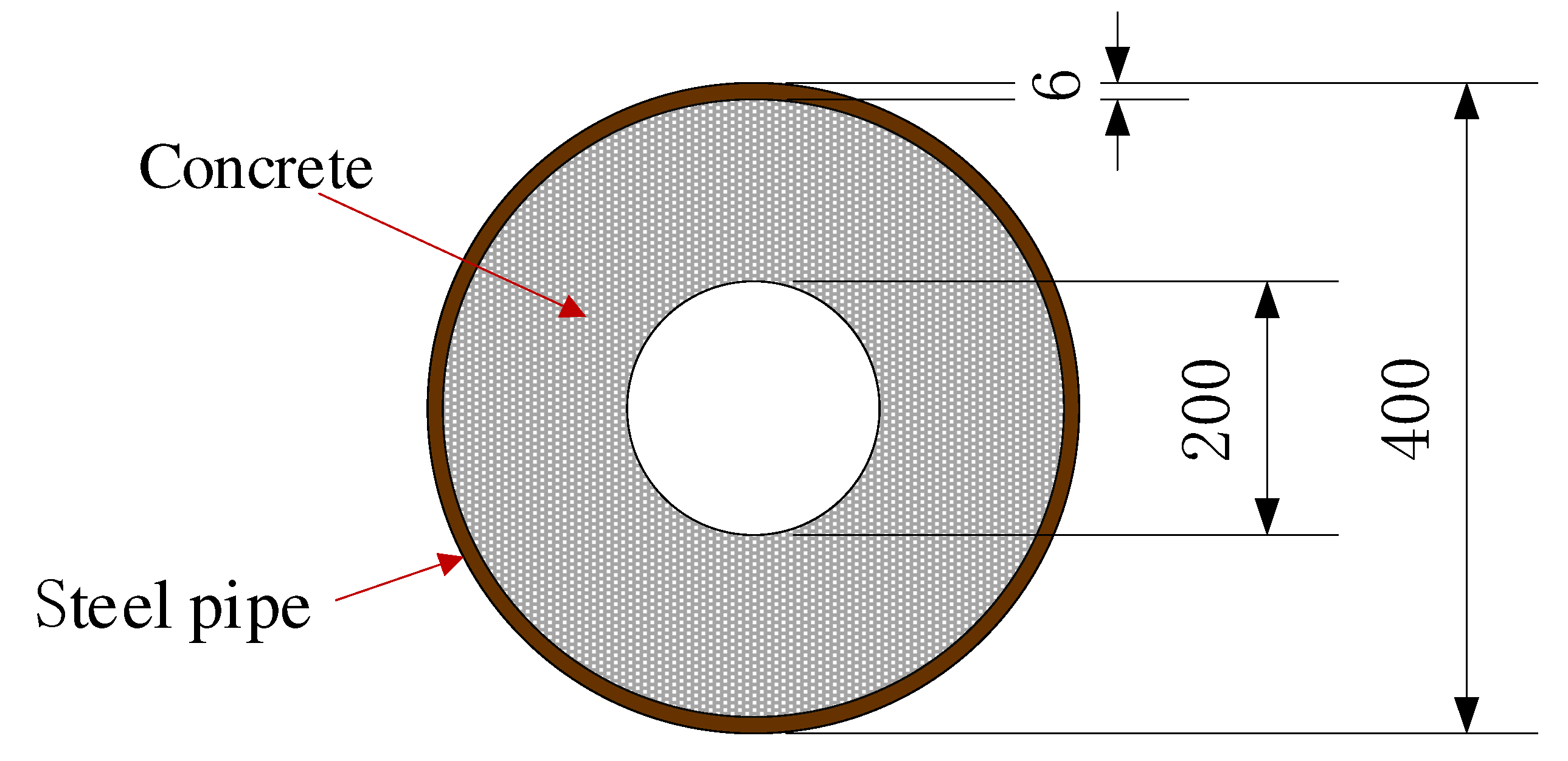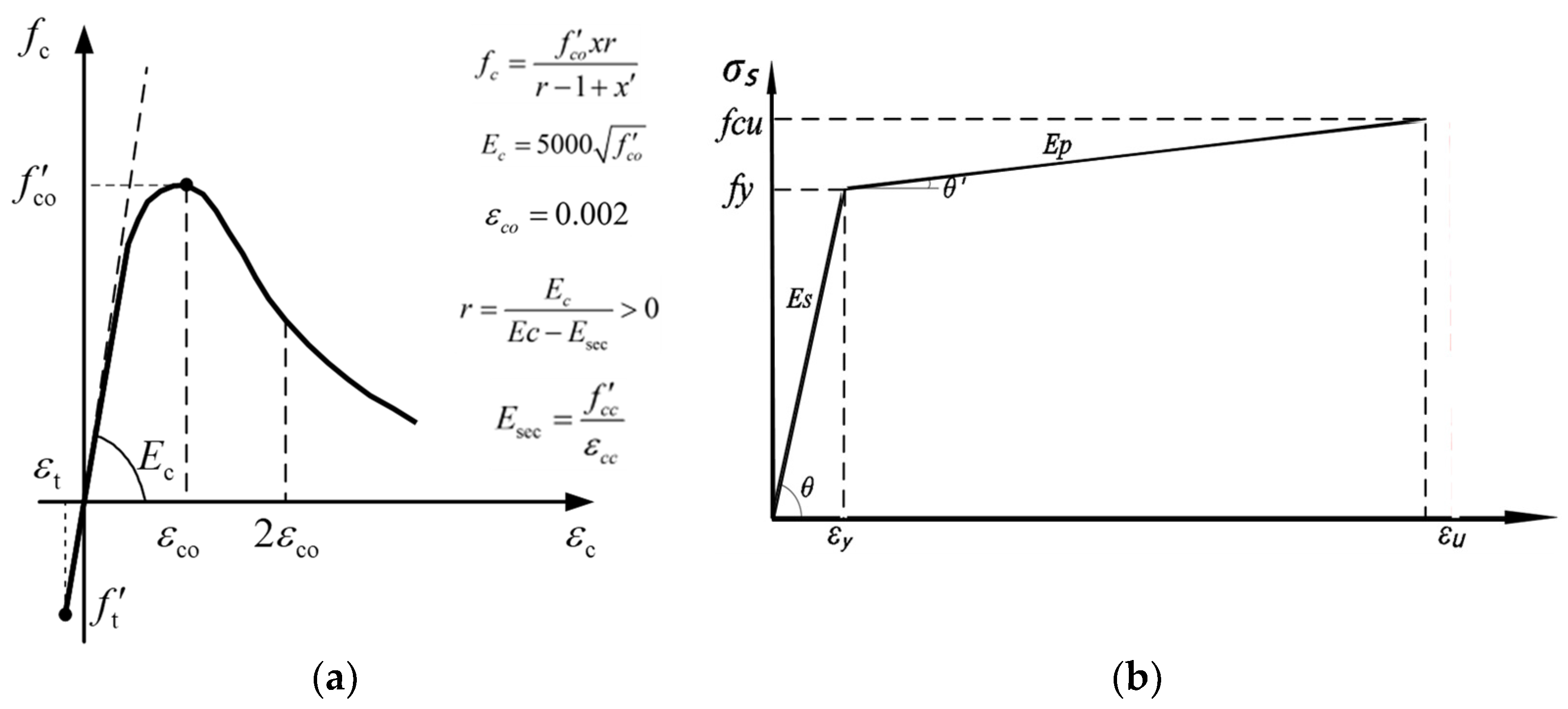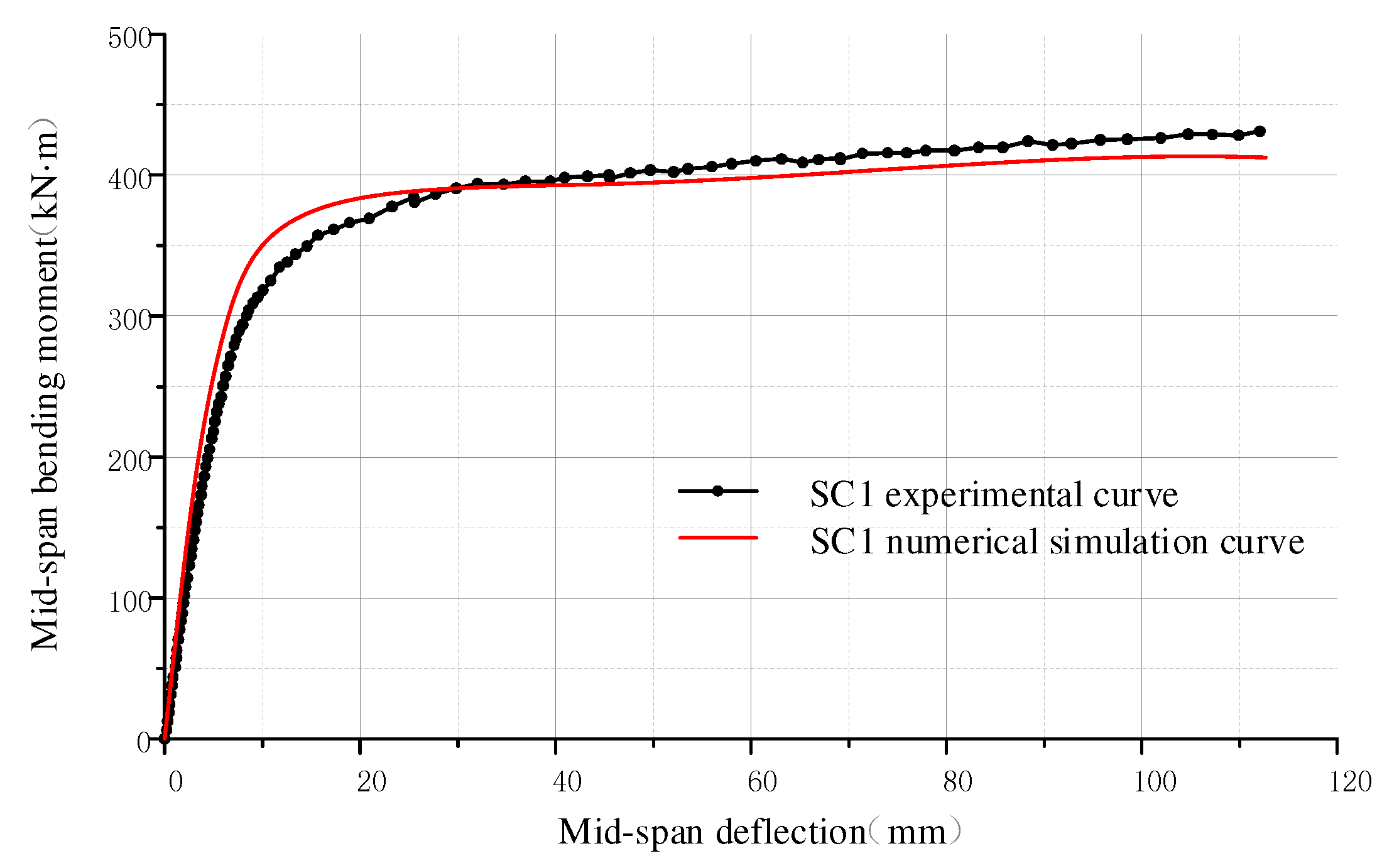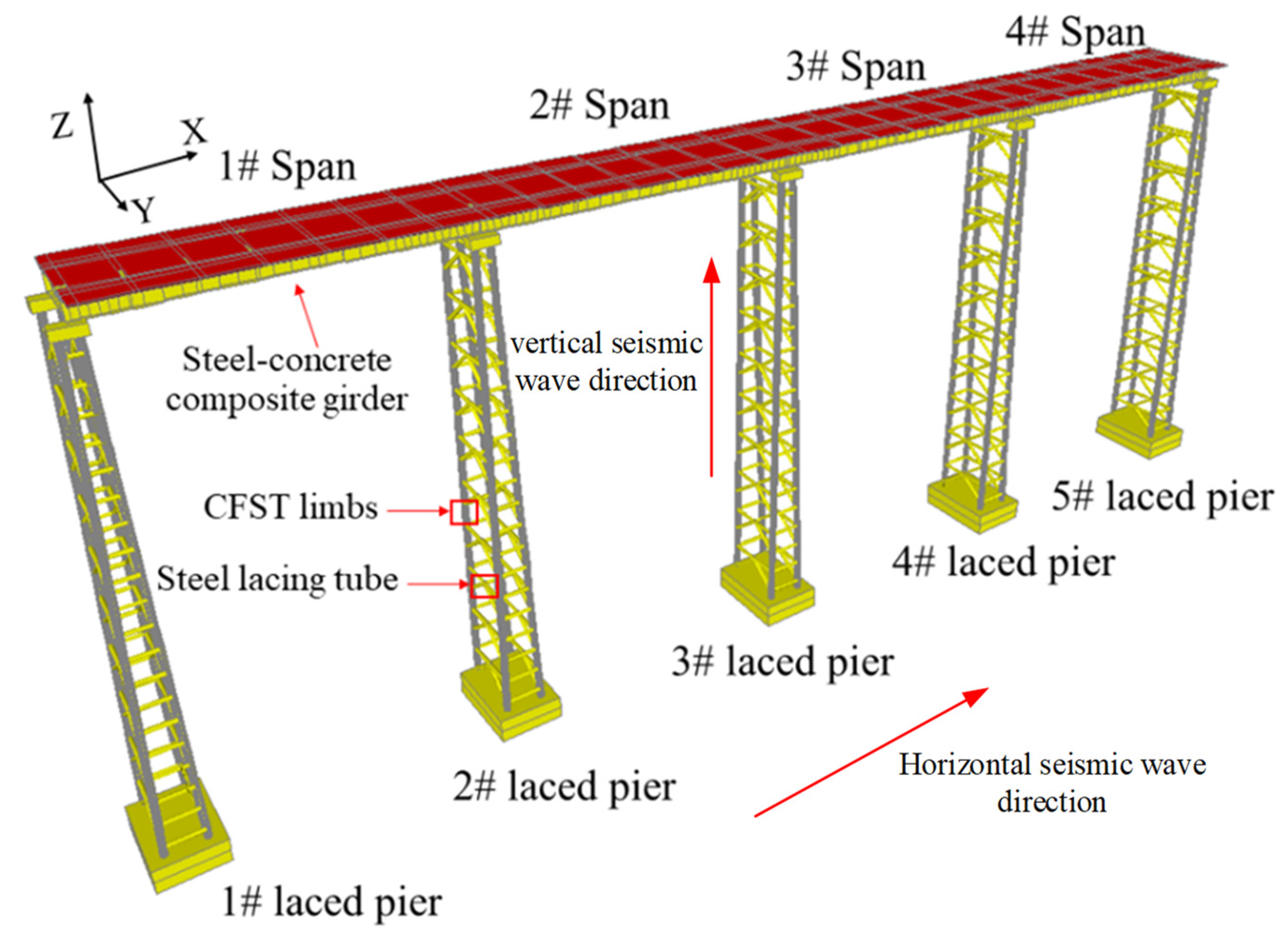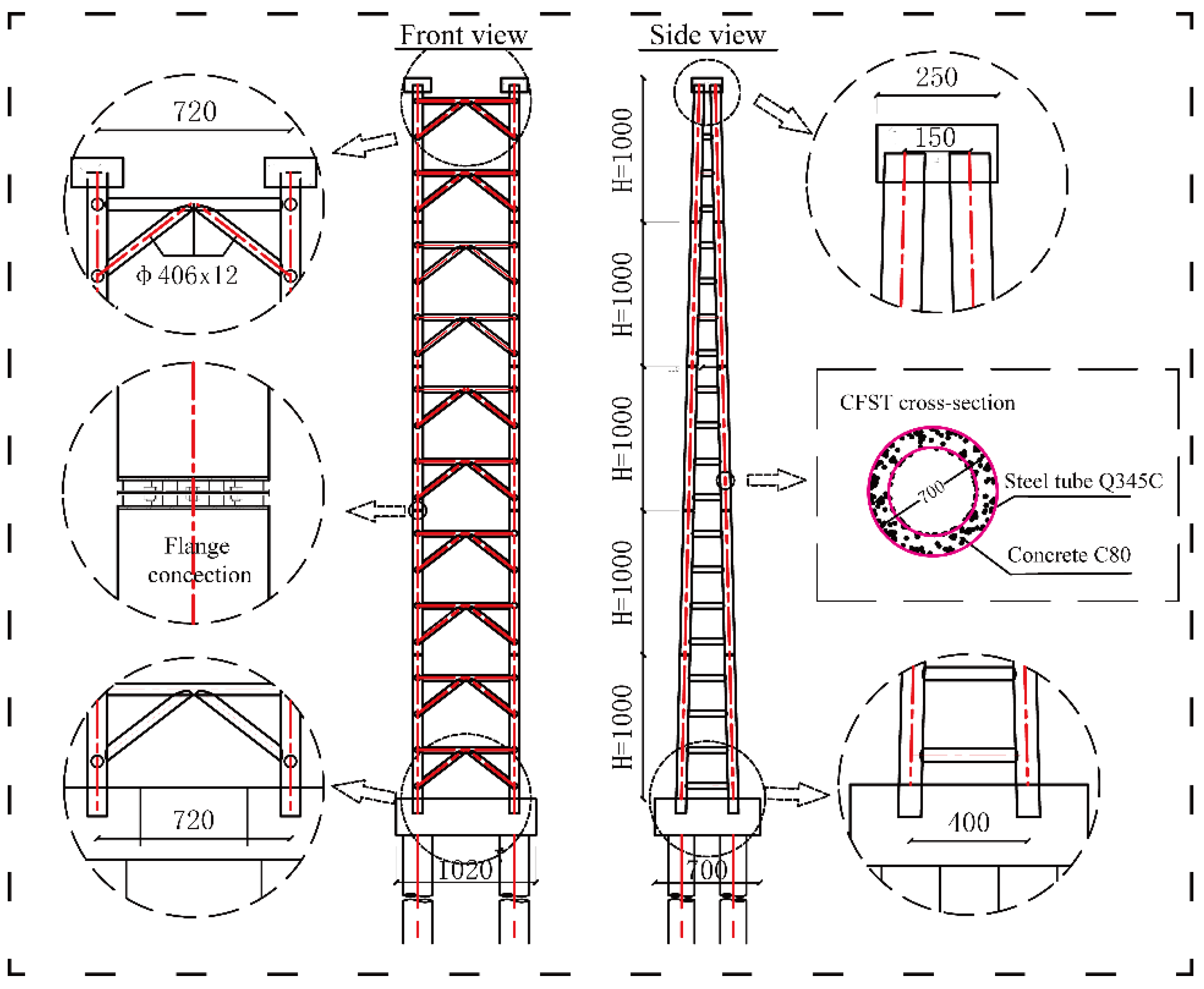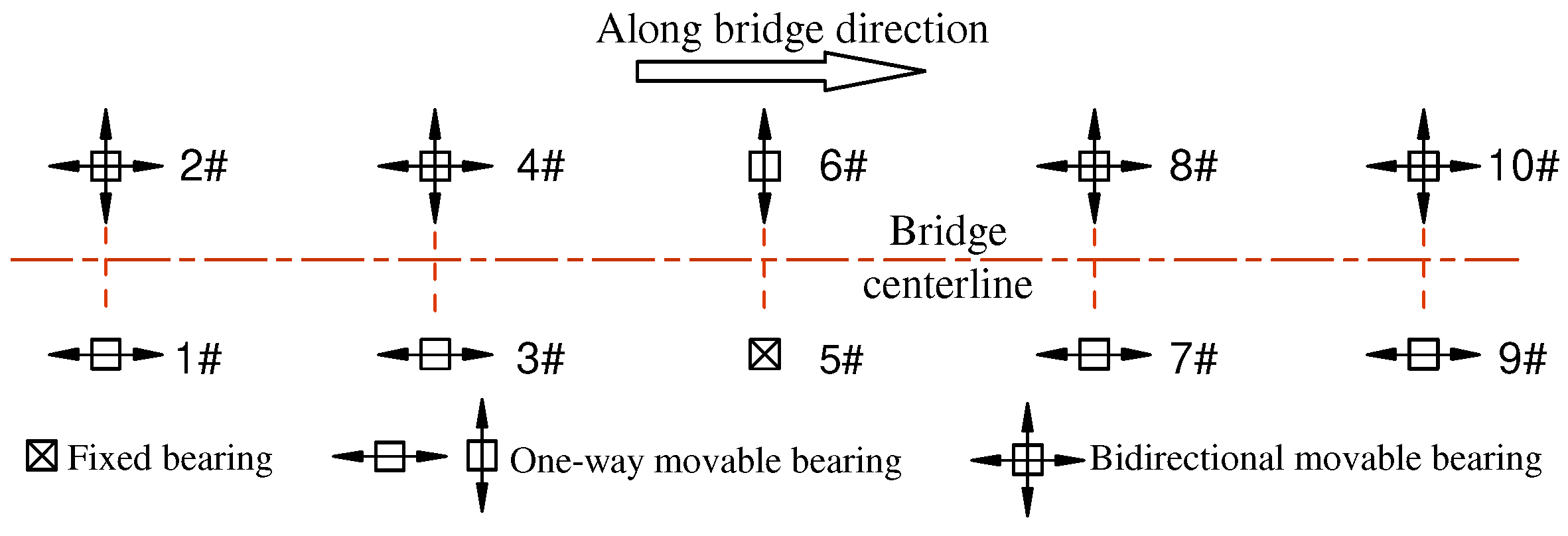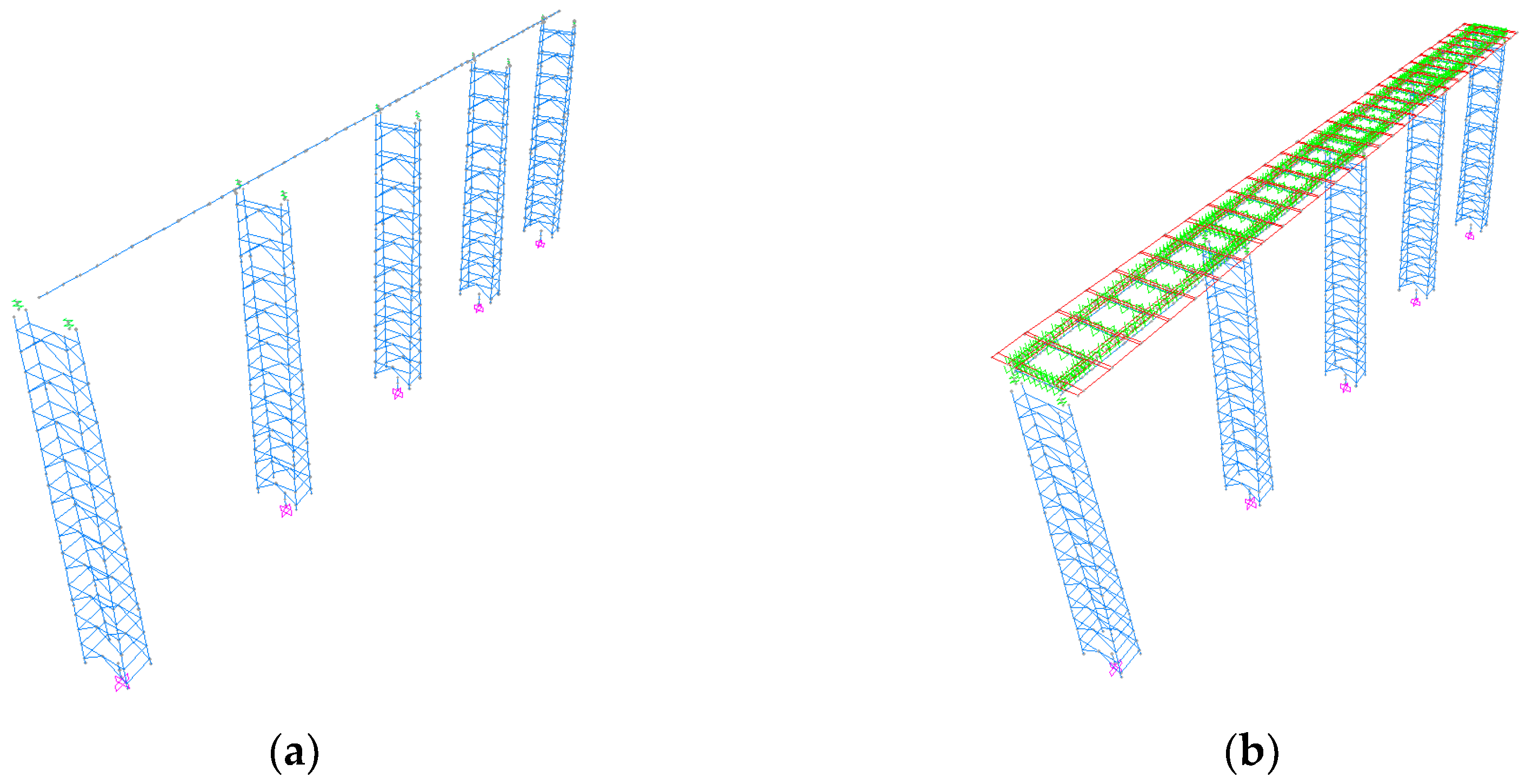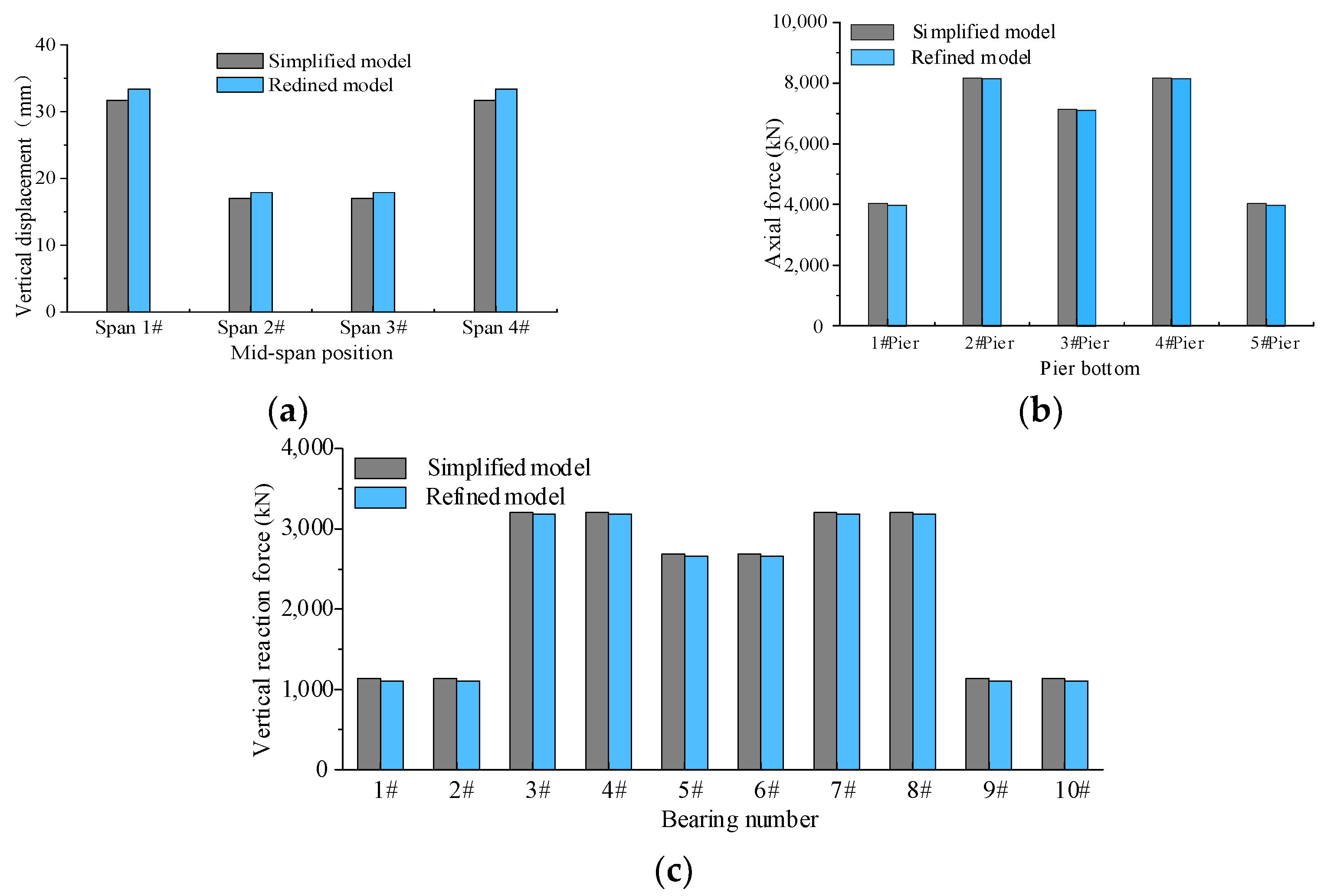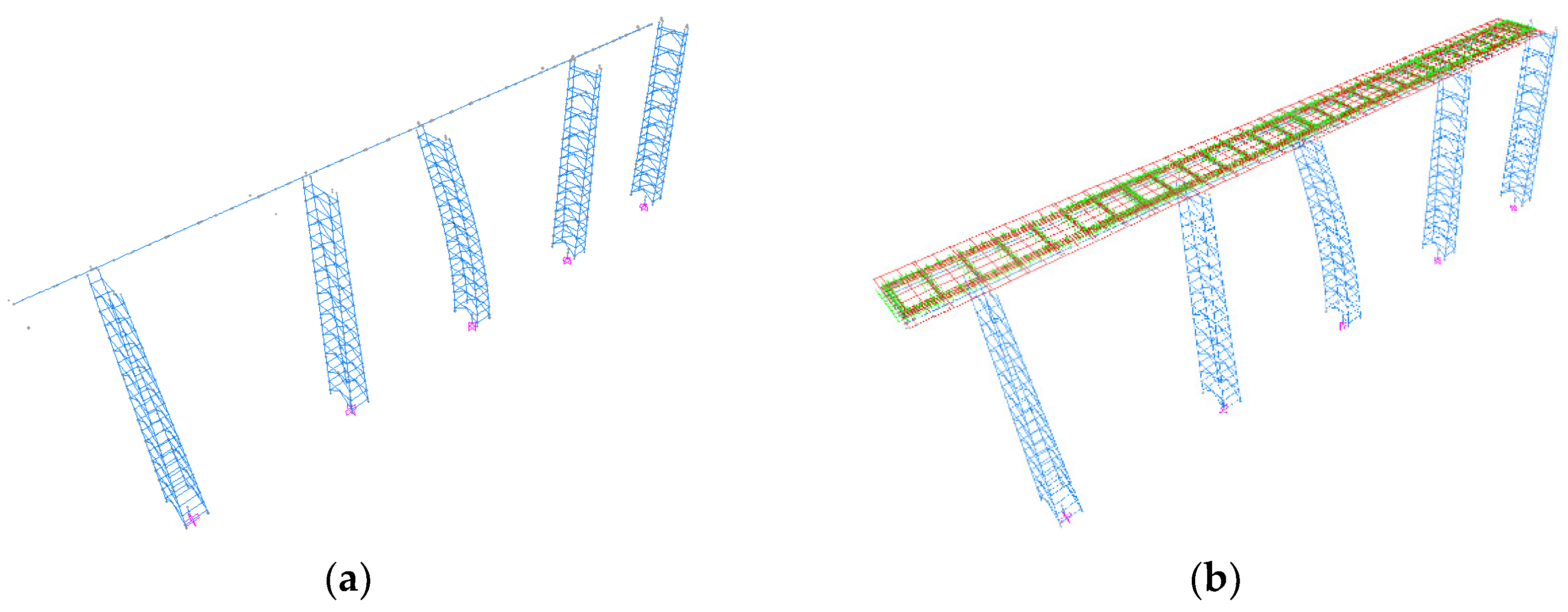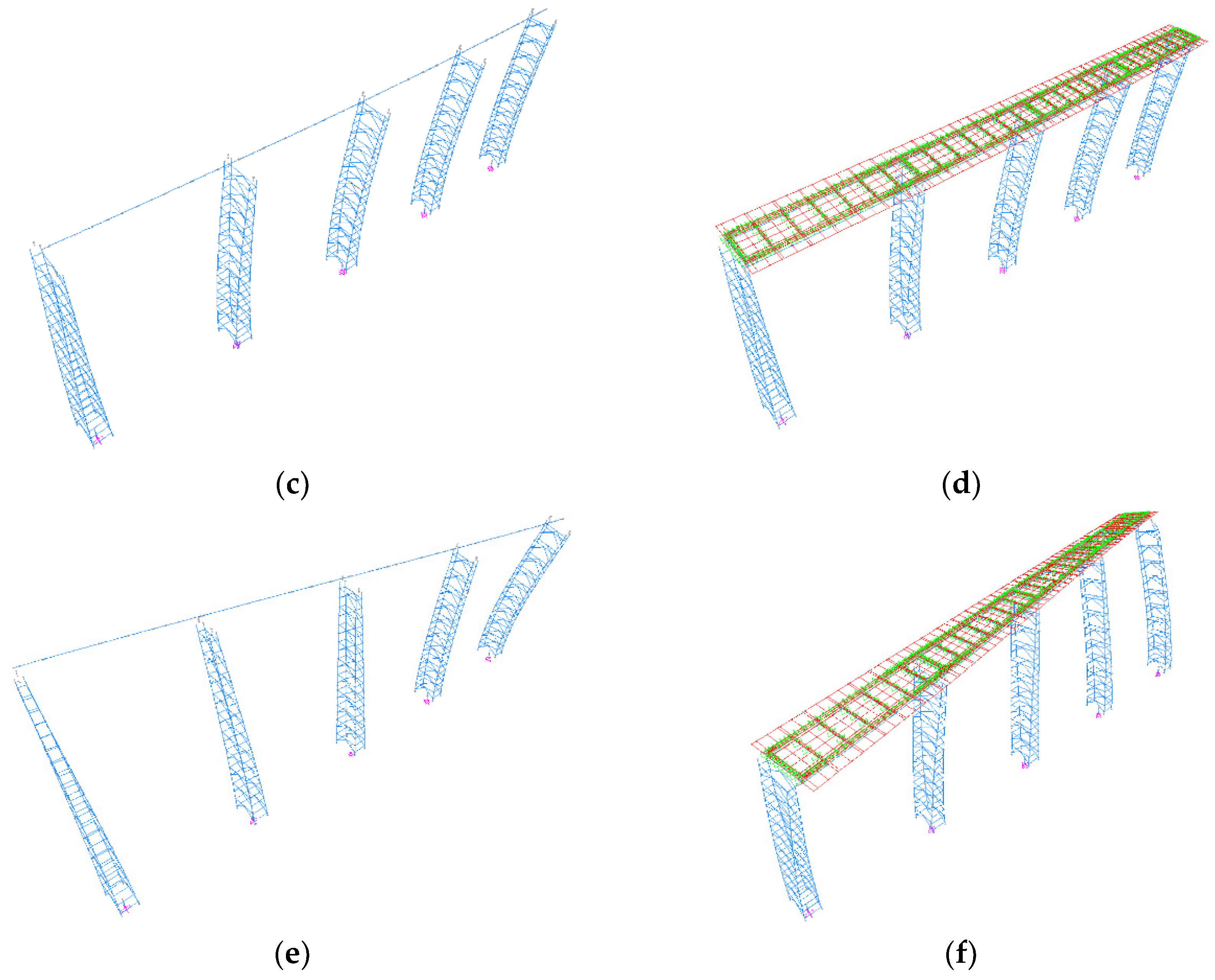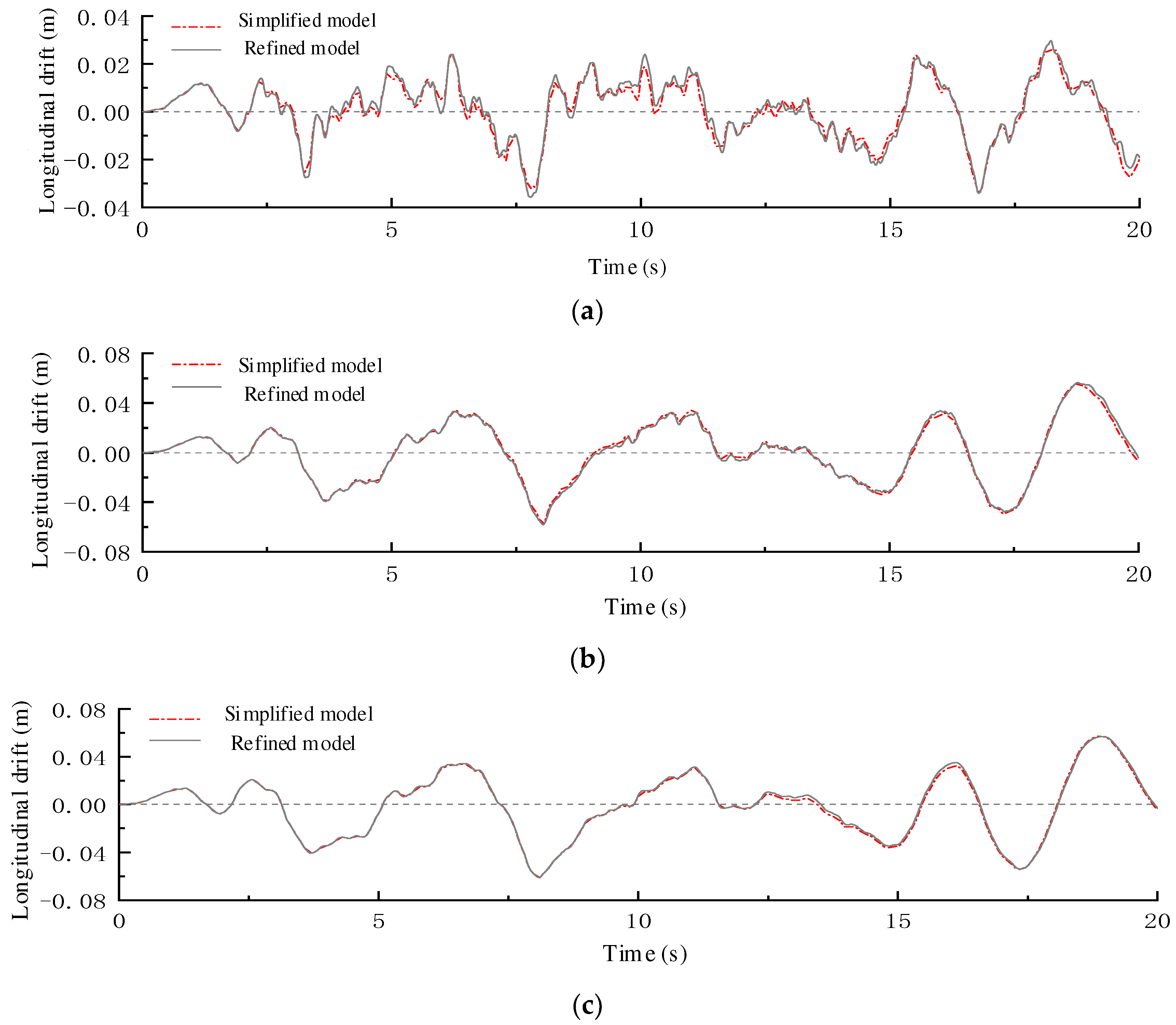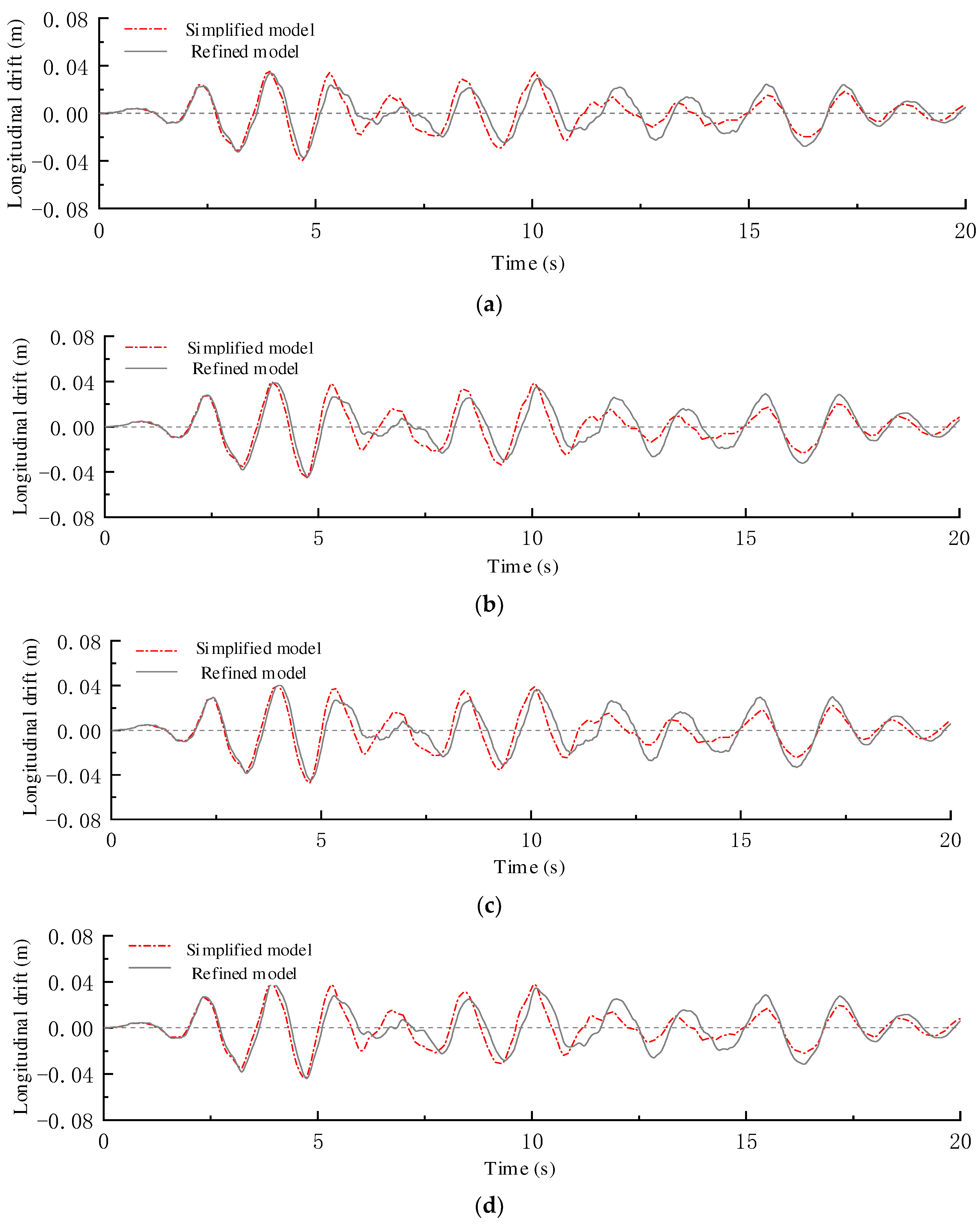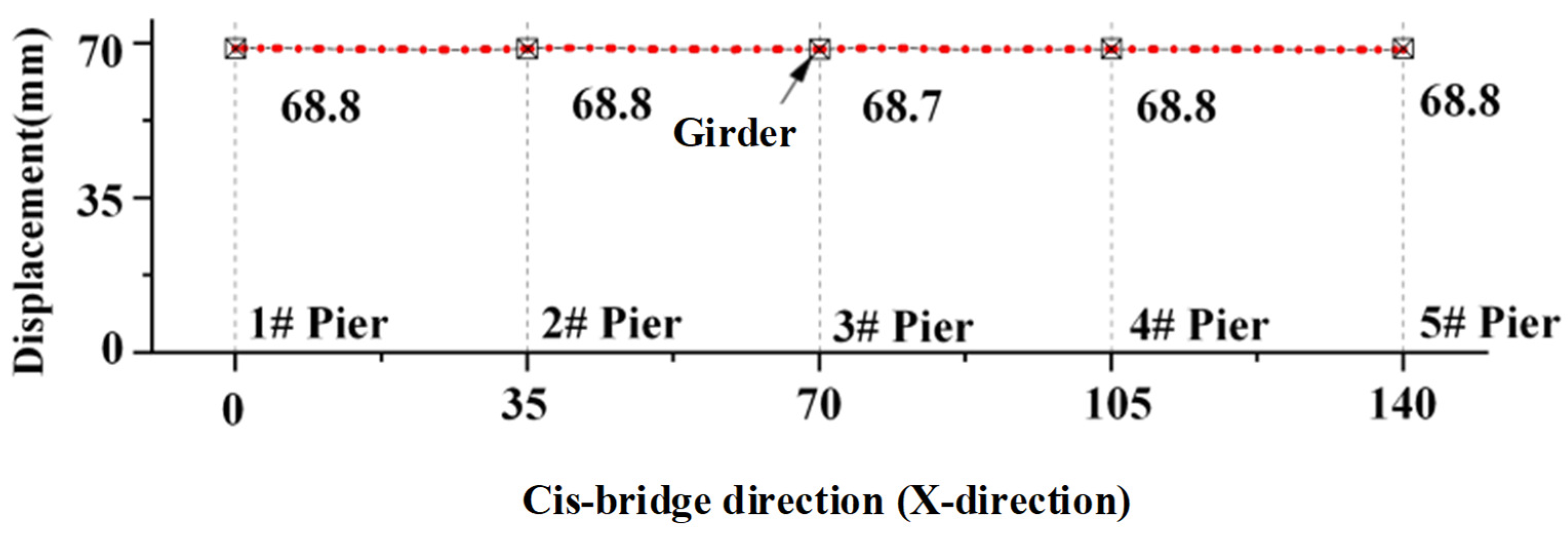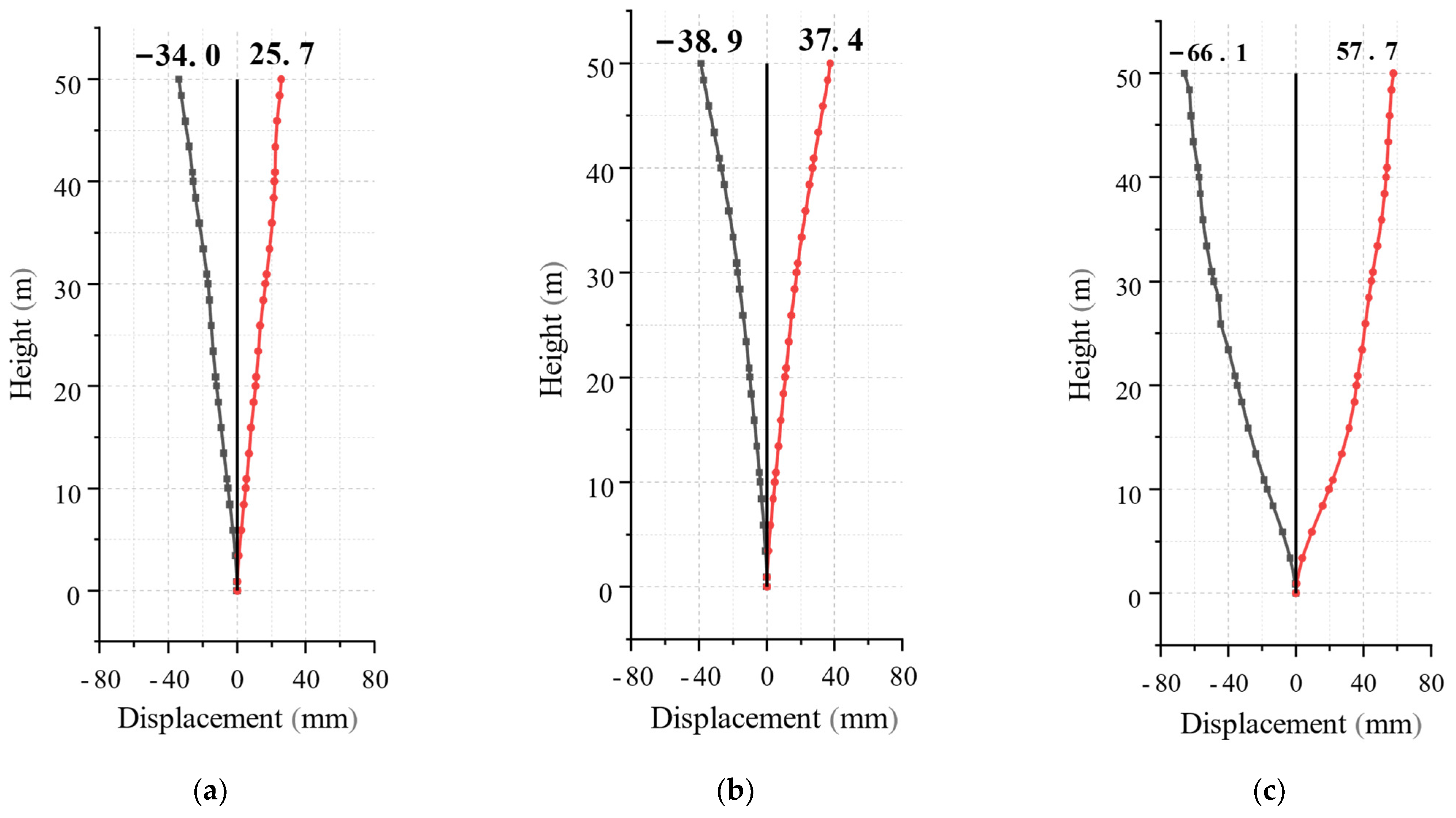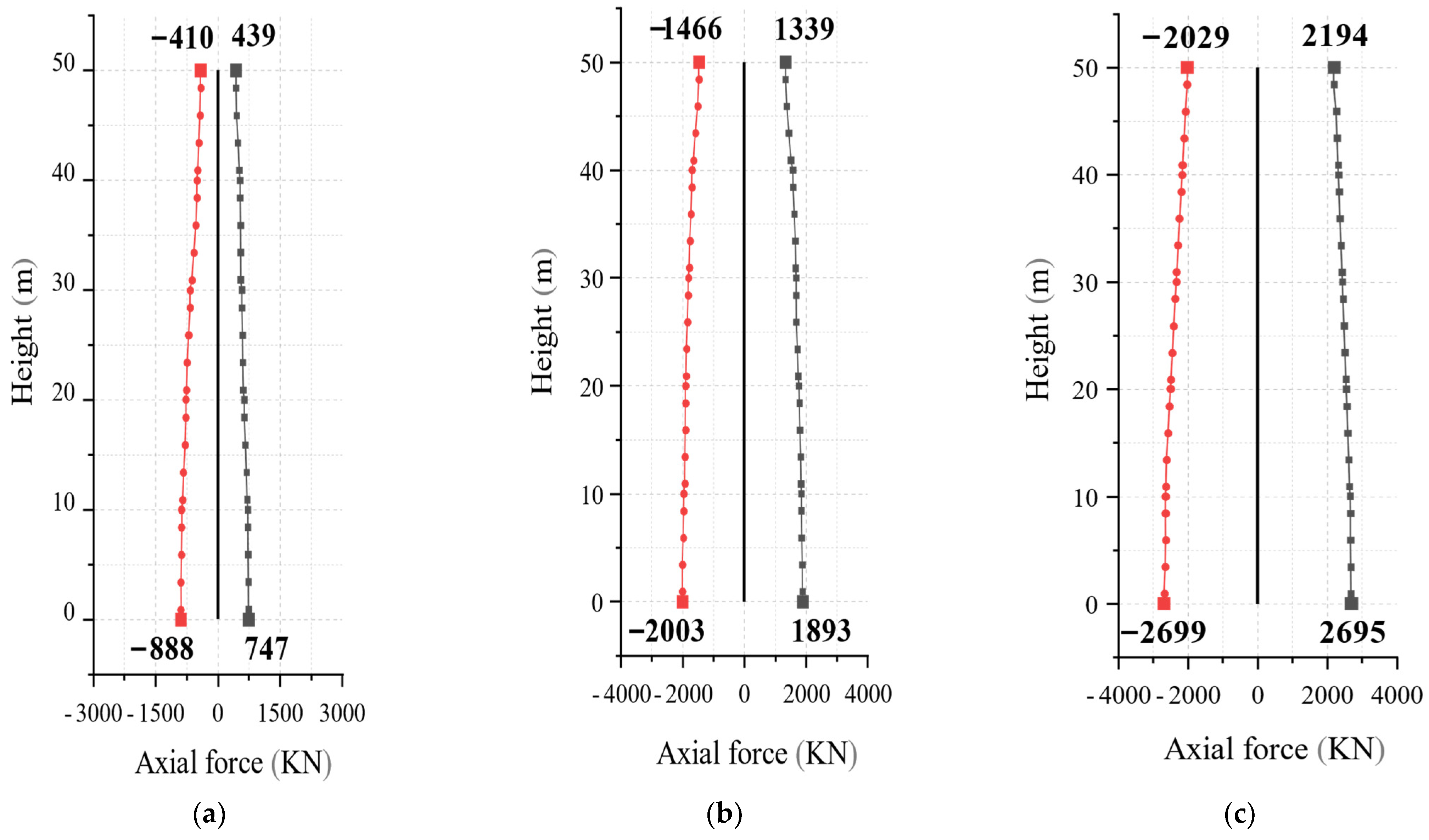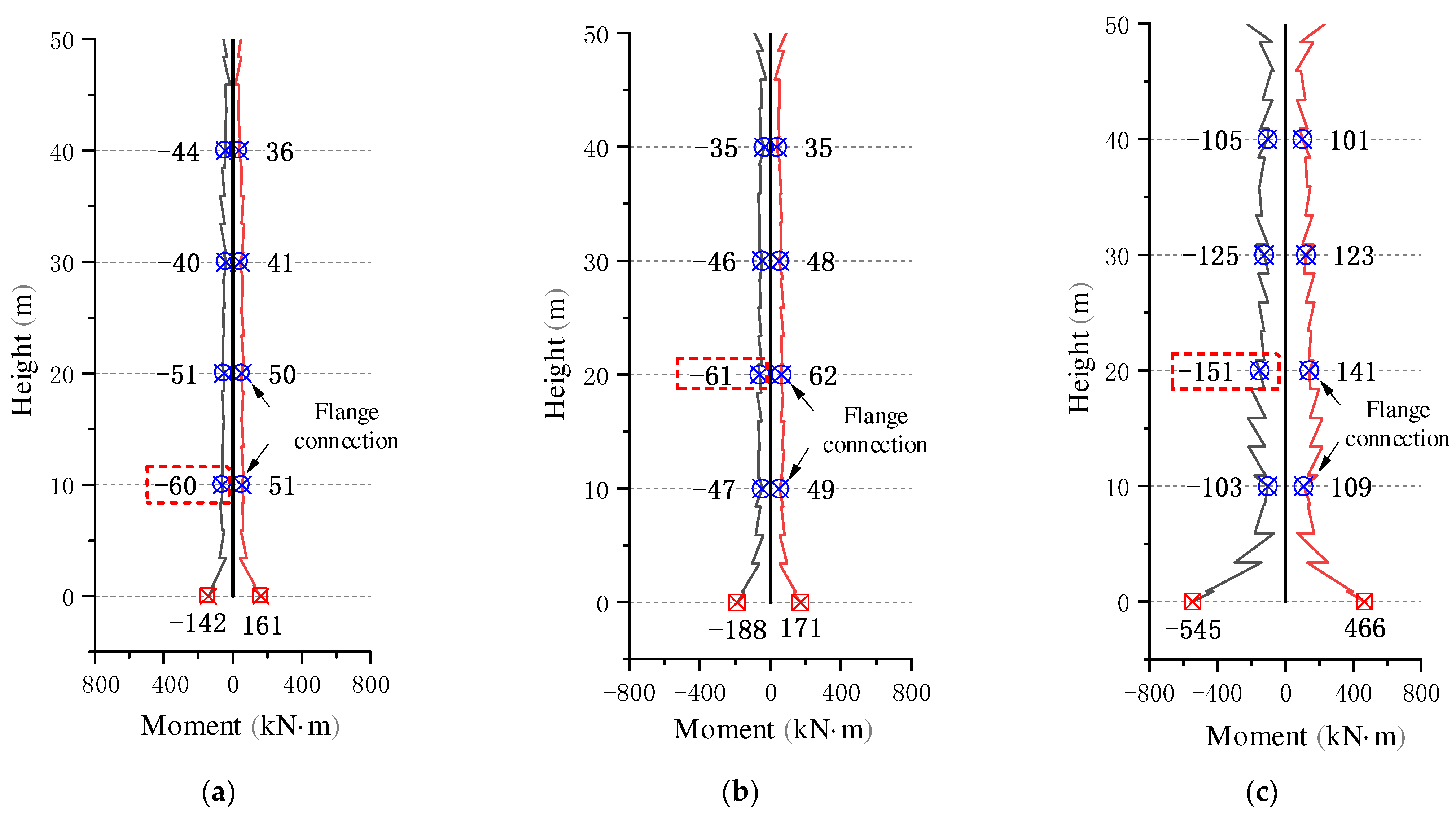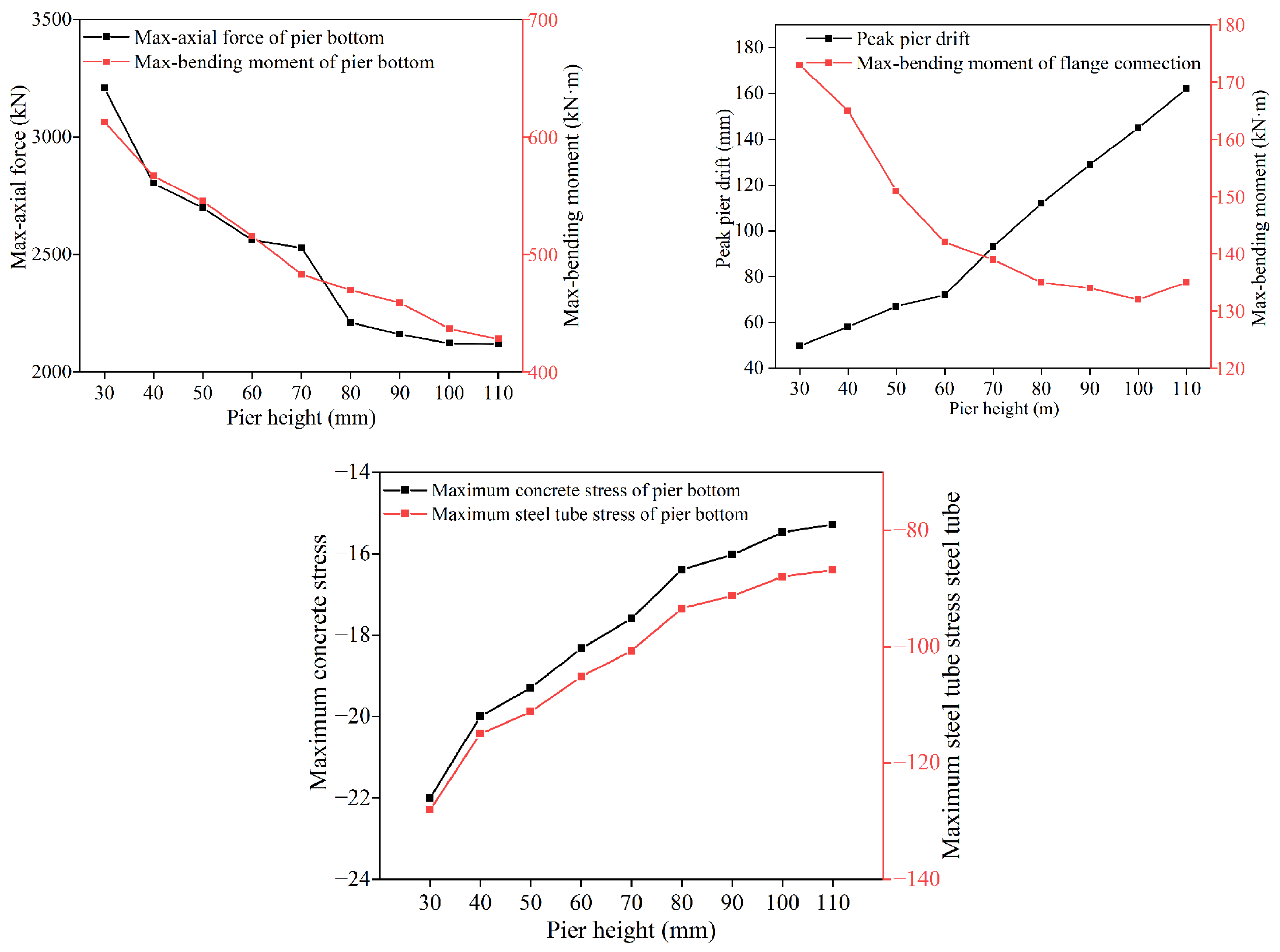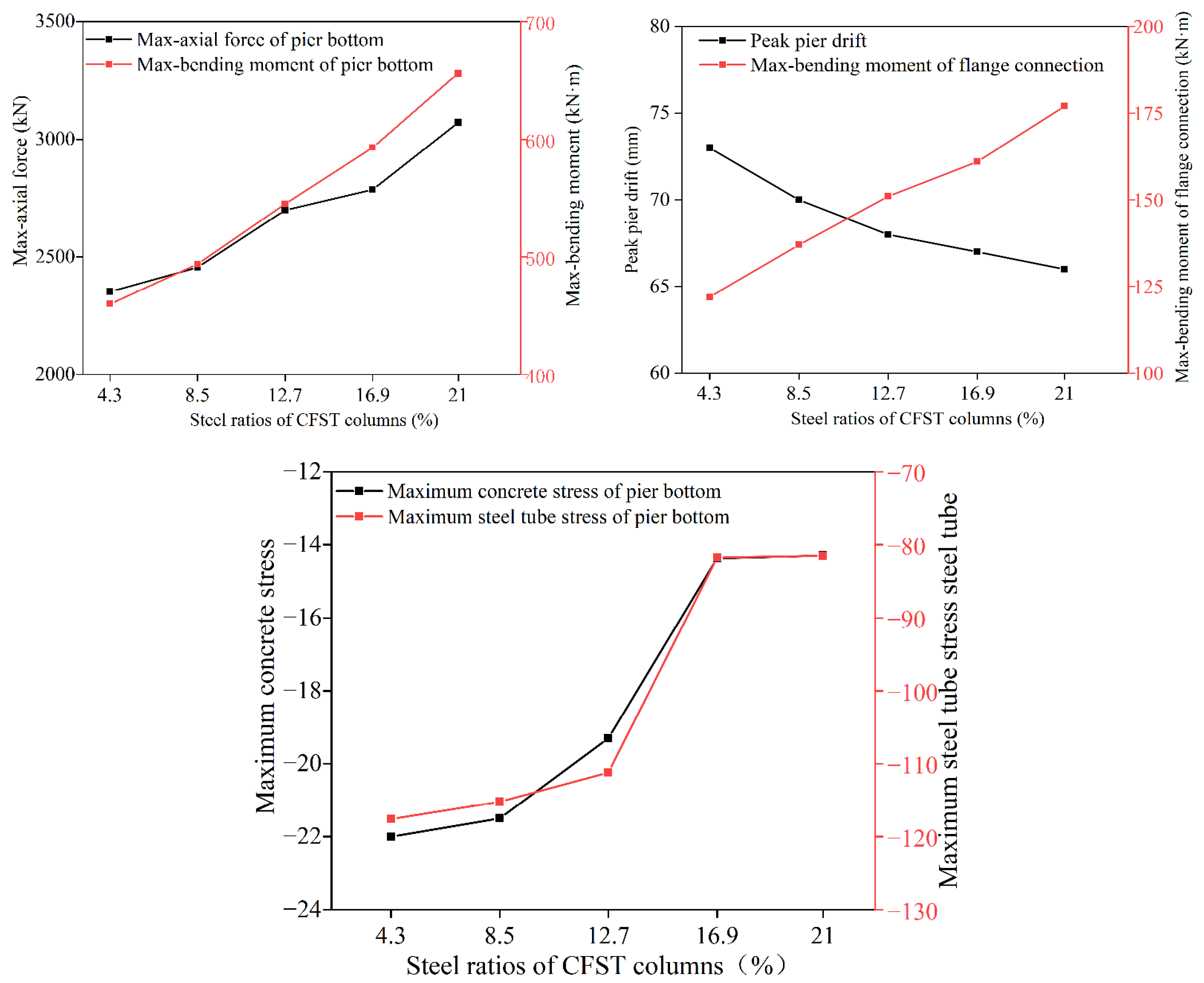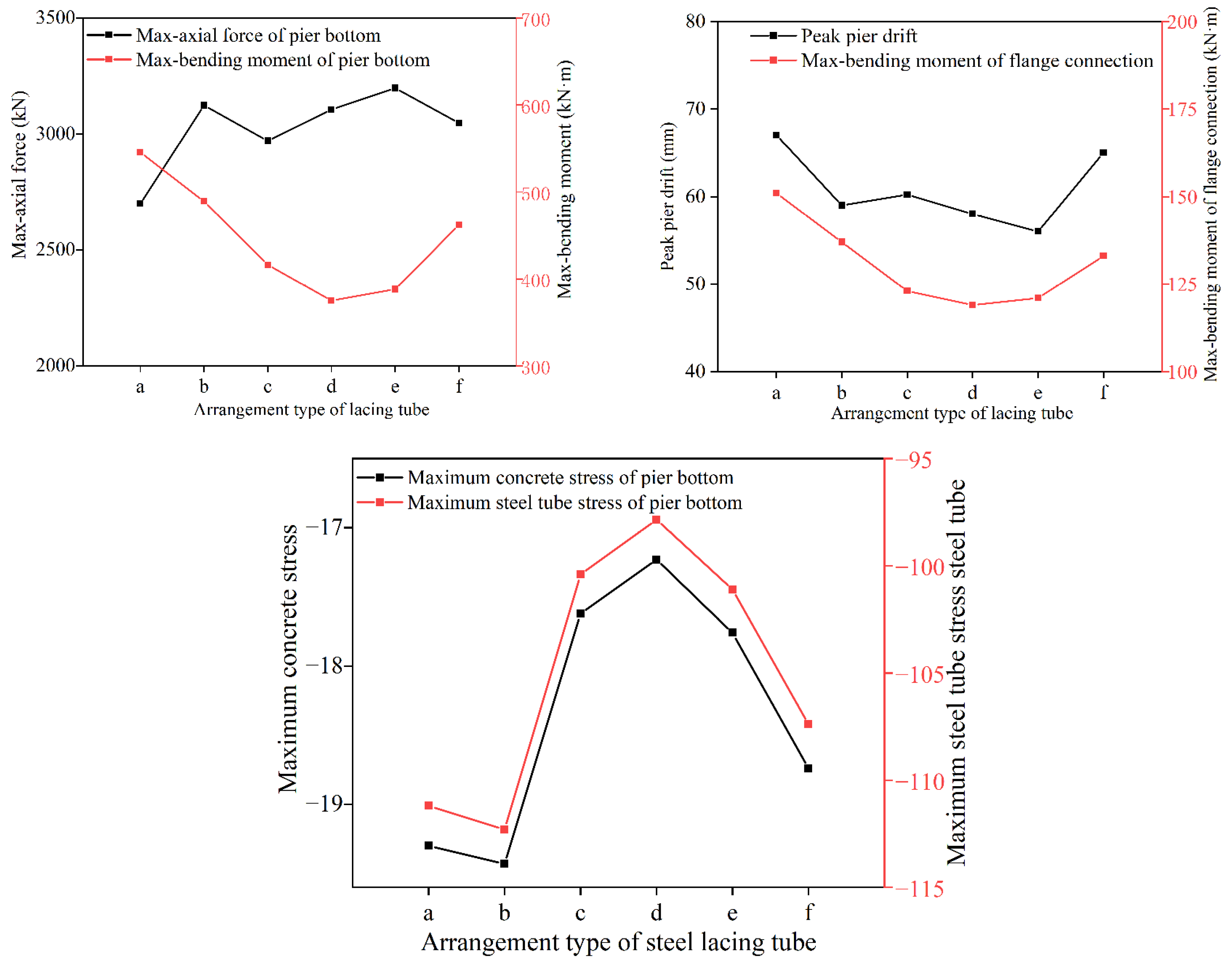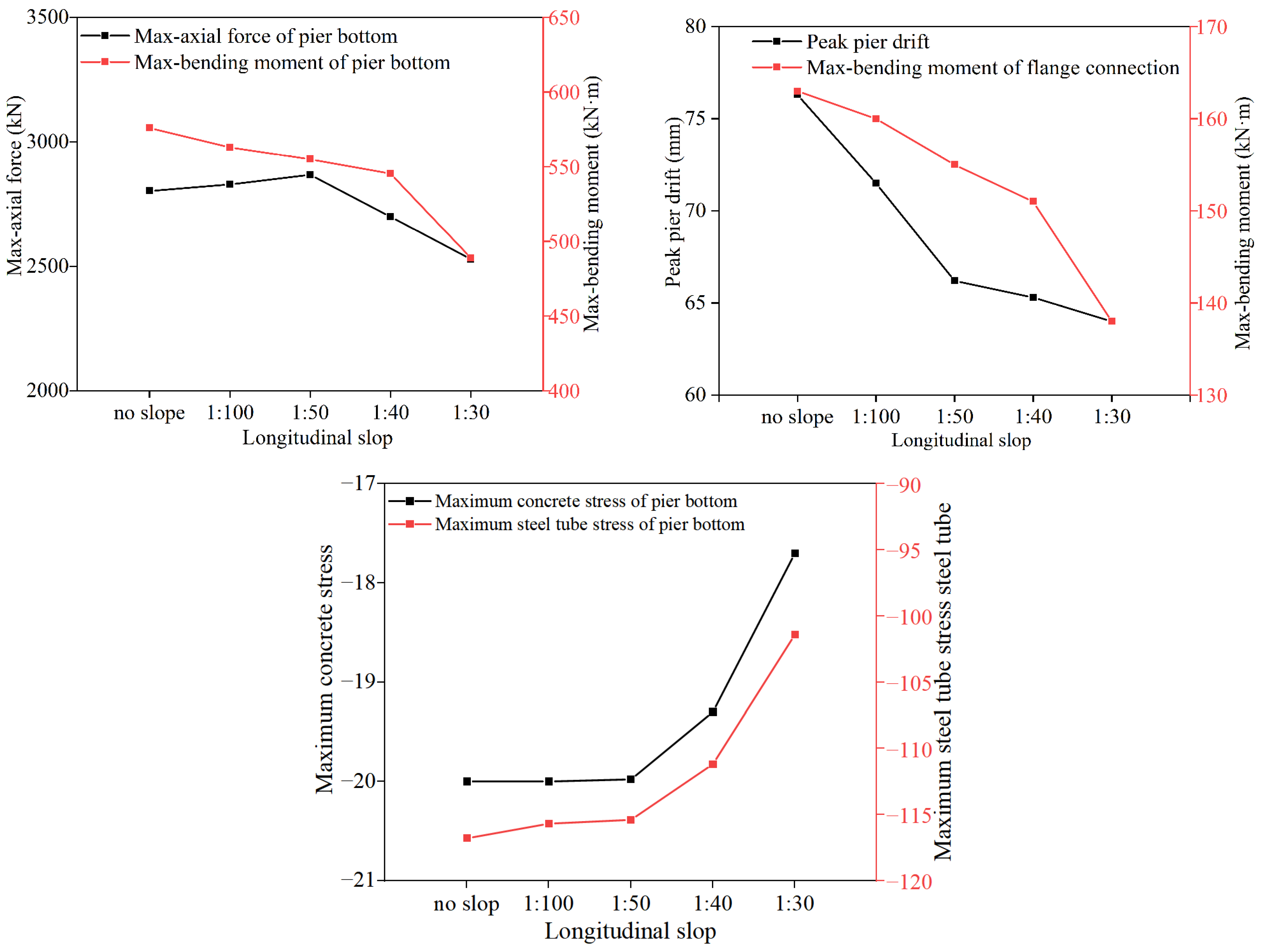Figure 1.
Cross-sectional view of the SC1 specimen.
Figure 1.
Cross-sectional view of the SC1 specimen.
Figure 2.
(
a) In situ photos of bending test [
16]; (
b) bending test apparatus. Bending performance test of the SC1 specimen.
Figure 2.
(
a) In situ photos of bending test [
16]; (
b) bending test apparatus. Bending performance test of the SC1 specimen.
Figure 3.
FEM of test specimens.
Figure 3.
FEM of test specimens.
Figure 4.
Material constitutive models in SAP2000. (a) Mander constitutive model for infilled concrete; (b) steel tube bilinear model.
Figure 4.
Material constitutive models in SAP2000. (a) Mander constitutive model for infilled concrete; (b) steel tube bilinear model.
Figure 5.
Comparison of experimental and simulated bending moment–deflection data.
Figure 5.
Comparison of experimental and simulated bending moment–deflection data.
Figure 6.
General layout of bridge with CFST-laced piers.
Figure 6.
General layout of bridge with CFST-laced piers.
Figure 7.
Cross-section of superstructure (unit: cm).
Figure 7.
Cross-section of superstructure (unit: cm).
Figure 8.
General layout of CFST-laced piers (unit: cm).
Figure 8.
General layout of CFST-laced piers (unit: cm).
Figure 9.
The layout of the support.
Figure 9.
The layout of the support.
Figure 10.
E2 acceleration response spectrum.
Figure 10.
E2 acceleration response spectrum.
Figure 11.
(a) S-model; (b) R-model. Diagrams of FEM.
Figure 11.
(a) S-model; (b) R-model. Diagrams of FEM.
Figure 12.
(a) Comparison of mid-span deflection; (b) comparison of pier bottom axial force; and (c) vertical reaction force of bearing. Comparison of static performance of two models.
Figure 12.
(a) Comparison of mid-span deflection; (b) comparison of pier bottom axial force; and (c) vertical reaction force of bearing. Comparison of static performance of two models.
Figure 13.
Comparison of the first three modes of the two models. (a) Simplified model—the first mode; (b) refined model—the first mode; (c) simplified model—the second mode; (d) refined model—the second mode; (e) simplified model—the third mode; and (f) refined model—the third mode.
Figure 13.
Comparison of the first three modes of the two models. (a) Simplified model—the first mode; (b) refined model—the first mode; (c) simplified model—the second mode; (d) refined model—the second mode; (e) simplified model—the third mode; and (f) refined model—the third mode.
Figure 14.
Comparison diagram of time history curve of lateral displacement (Y-axis direction). (a) Lateral drift of 1# pier top; (b) lateral drift of 2# pier top; (c) lateral drift of 3# pier top; and (d) lateral drift of mid-span superstructure.
Figure 14.
Comparison diagram of time history curve of lateral displacement (Y-axis direction). (a) Lateral drift of 1# pier top; (b) lateral drift of 2# pier top; (c) lateral drift of 3# pier top; and (d) lateral drift of mid-span superstructure.
Figure 15.
Comparison diagram of time history curve of longitudinal displacement (X-axis direction). (a) Longitudinal drift of 1# pier top; (b) longitudinal drift of 2# pier top; (c) longitudinal drift of 3# pier top; (d) and longitudinal drift of mid-span superstructure.
Figure 15.
Comparison diagram of time history curve of longitudinal displacement (X-axis direction). (a) Longitudinal drift of 1# pier top; (b) longitudinal drift of 2# pier top; (c) longitudinal drift of 3# pier top; (d) and longitudinal drift of mid-span superstructure.
Figure 16.
Peak longitudinal displacement of the girder.
Figure 16.
Peak longitudinal displacement of the girder.
Figure 17.
Horizontal displacement envelope diagram of each pier. (a) 1#Pier; (b) 2#Pier; (c) 3#Pier.
Figure 17.
Horizontal displacement envelope diagram of each pier. (a) 1#Pier; (b) 2#Pier; (c) 3#Pier.
Figure 18.
Axial force envelope diagram of each pier. (a) 1#Pier; (b) 2#Pier; (c) 3#Pier.
Figure 18.
Axial force envelope diagram of each pier. (a) 1#Pier; (b) 2#Pier; (c) 3#Pier.
Figure 19.
Envelope diagram of bending moment of each pier. (a) 1#Pier; (b) 2#Pier; (c) 3#Pier.
Figure 19.
Envelope diagram of bending moment of each pier. (a) 1#Pier; (b) 2#Pier; (c) 3#Pier.
Figure 20.
Comparison of maximum seismic response under different pier heights.
Figure 20.
Comparison of maximum seismic response under different pier heights.
Figure 21.
Comparison of response peaks under different axial compression ratios.
Figure 21.
Comparison of response peaks under different axial compression ratios.
Figure 22.
Comparison of maximum seismic response under different column steel ratios.
Figure 22.
Comparison of maximum seismic response under different column steel ratios.
Figure 23.
Arrangement type of steel lacing tube. (a) A-type; (b) B-type; (c) C-type; (d) D-type; (e) E-type; and (f) F-type.
Figure 23.
Arrangement type of steel lacing tube. (a) A-type; (b) B-type; (c) C-type; (d) D-type; (e) E-type; and (f) F-type.
Figure 24.
Comparison of the maximum seismic response under different arrangement types of steel lacing tube.
Figure 24.
Comparison of the maximum seismic response under different arrangement types of steel lacing tube.
Figure 25.
Comparison of maximum seismic response under different column slopes.
Figure 25.
Comparison of maximum seismic response under different column slopes.
Figure 26.
Comparison of seismic response peaks before and after optimization.
Figure 26.
Comparison of seismic response peaks before and after optimization.
Table 1.
SC1 test specimen material properties.
Table 1.
SC1 test specimen material properties.
| Component | Compressive Strength (Mpa) | Yield Strength (Mpa) | Tensile Strength (Mpa) |
|---|
| Grout-filled concrete (C80) | 50.2 | | |
| Steel pipe (Q235B) | | 243.5 | 512.3 |
Table 2.
Material properties.
Table 2.
Material properties.
| Component | Compressive Strength (Mpa) | Yield Strength (Mpa) | Tensile Strength (Mpa) |
|---|
| C35 | 23.4 | | |
| C40 | 26.8 | | |
| C80 | 50.2 | | |
| Q235B | | 243.5 | 512.3 |
| Q345B | | 356.4 | 623.8 |
Table 3.
The design parameters of the original bridge scheme.
Table 3.
The design parameters of the original bridge scheme.
| Parameters | Values | Parameters | Values |
|---|
| Pier height | 50 m | Single span | 35 m |
| Longitudinal slope | 1:40 | Steel ratio of CFST (wall thickness of steel tube) | 12.7% (12 mm) |
| Axial compression ratio | 0.1 | Strength of steel | Q345 |
| Arrangement type of lacing tube | K-shaped layout | Concrete strength of CFST | C80 |
Table 4.
The difference between the two finite element models.
Table 4.
The difference between the two finite element models.
| | Superstructures | Substructures (Laced Columns) | Others |
|---|
| Simplified model | Frame element | Equivalent section | Identical |
| Refined model | shell element, frame element, and Link units | Combined section of CFST |
Table 5.
The first ten cycles comparison table.
Table 5.
The first ten cycles comparison table.
| Mode Order | Simplified Model | Refined Model | Relative Errors |
|---|
| Natural Periods (s) | Mass Participation Factors | Natural Periods (s) | Mass Participation Factors |
|---|
| 1 | 6.225 | 0.597 | 6.237 | 0.597 | 0.19% |
| 2 | 1.530 | 0 | 1.581 | 0 | 3.23% |
| 3 | 1.256 | 0 | 1.318 | 0 | 4.70% |
| 4 | 0.897 | 3.753 × 10−10 | 0.895 | 6.773 × 10−16 | 0.22% |
| 5 | 0.897 | 0.0176 | 0.895 | 0.0177 | 0.22% |
| 6 | 0.897 | 2.041 × 10−5 | 0.895 | 2.844 × 10−13 | 0.22% |
| 7 | 0.897 | 3.25 × 10−10 | 0.892 | 1.002 × 10−6 | 0.56% |
| 8 | 0.494 | 0.0451 | 0.514 | 0.04521 | 3.89% |
| 9 | 0.475 | 0 | 0.476 | 0 | 0.21% |
| 10 | 0.395 | 2.692 × 10−6 | 0.439 | 1.421 × 10−6 | 9.94% |
Table 6.
The first ten vibration characteristics.
Table 6.
The first ten vibration characteristics.
| Mode Order | Mode Shapes |
|---|
| Simplified Model | Refined Model |
|---|
| 1 | Longitudinal vibration of superstructure |
| 2 | Symmetrical lateral bending of superstructure |
| 3 | Antisymmetrical lateral bending of superstructure | Transverse antisymmetric bending and twisting of superstructure |
| 4 | 5# Pier longitudinal bending |
| 5 | 1# Pier longitudinal bending |
| 6 | 4# Pier longitudinal bending |
| 7 | 3# Pier longitudinal bending |
| 8 | Symmetrical lateral bending of superstructure, 1#, 5# pier floating horizontally | Symmetrical lateral bending of superstructure |
| 9 | 3# Pier longitudinal bending |
| 10 | Antisymmetric vertical bending of superstructure |
Table 7.
Comparison of first mode period under different pier heights.
Table 7.
Comparison of first mode period under different pier heights.
| Pier Height | First Mode Period (s) |
|---|
| 30 m | 4.648 |
| 40 m | 5.423 |
| 50 m | 6.225 |
| 60 m | 6.973 |
| 70 m | 7.938 |
| 80 m | 8.522 |
| 90 m | 9.591 |
| 100 m | 10.072 |
| 110 m | 11.175 |
Table 8.
Comparison of first mode period under different column steel ratios.
Table 8.
Comparison of first mode period under different column steel ratios.
| Column Steel Ratios | First Mode Period (s) |
|---|
| 4.3 | 6.840 |
| 8.5 | 6.496 |
| 12.7 | 6.225 |
| 16.9 | 6.005 |
| 21 | 5.712 |
Table 9.
Comparison of first mode period under different arrangement types of steel lacing tube.
Table 9.
Comparison of first mode period under different arrangement types of steel lacing tube.
| Arrangement Type of Steel Lacing Tube | First Mode Period (s) |
|---|
| A | 9.290 |
| B | 6.039 |
| C | 6.030 |
| D | 6.048 |
| E | 6.076 |
| F | 8.906 |
Table 10.
Comparison of first mode period under different Longitudinal Slope.
Table 10.
Comparison of first mode period under different Longitudinal Slope.
| Column Slopes | First Mode Period (s) |
|---|
| No slope | 7.367 |
| 1:100 | 7.034 |
| 1:50 | 6.641 |
| 1:40 | 6.225 |
| 1:30 | 5.167 |
Table 11.
Influence law of different design parameters of lattice pier.
Table 11.
Influence law of different design parameters of lattice pier.
| Parameter | Displacement of Top of Pier | Axial Force of Bottom of Pier | Bending Moment of Bottom of Pier | Bending Moment of Flange | Importance | Recommended Value |
|---|
| Pier height | positive correlation | positive correlation | negative correlation | negative correlation | Im | —— |
| Axial compression ratios | positive correlation | positive correlation | positive correlation | positive correlation | Im | About 0.1 |
| Steel ratios of CFST columns | negative correlation | positive correlation | positive correlation | positive correlation | More im | variable cross-section |
| Arrangement type of lacing tube | It mainly affects the bending moment of pier bottom and flange | Less im | A, C, D-type |
| Longitudinal slope | negative correlation | negative correlation | negative correlation | negative correlation | Insign | 1:50~1:30 |
Table 12.
Comparison of design parameters of laced piers before and after optimization.
Table 12.
Comparison of design parameters of laced piers before and after optimization.
| Parameters | Original Design Scheme | Optimized Design Scheme |
|---|
| Axial compression ratios | 0.1 | 0.1 |
| Steel ratios of CFST | 12.7% | variable cross-section of steel tube |
| Arrangement type of lacing tube | A-type | D-type |
| Longitudinal slope | 1:40 | 1:30 |
